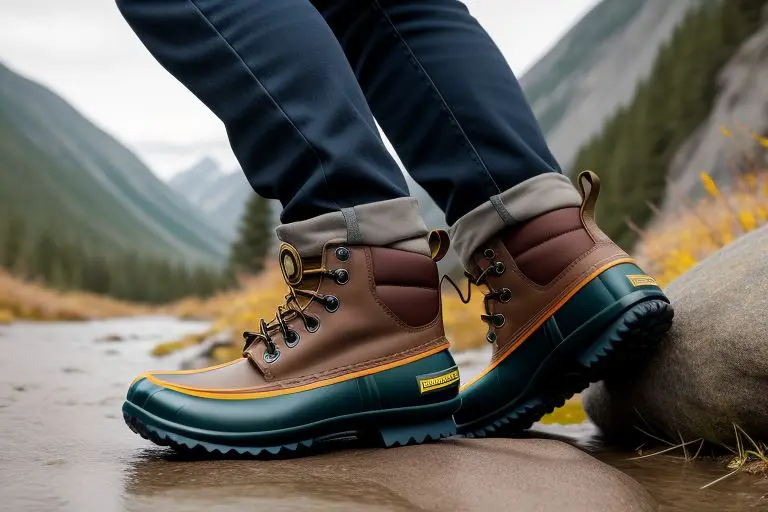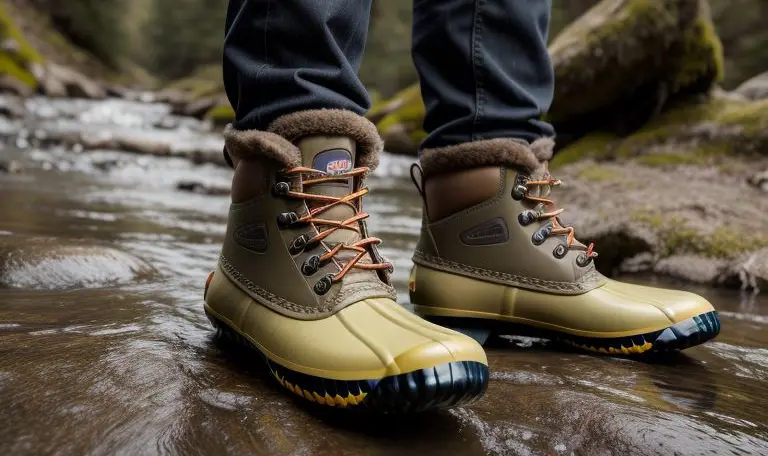Are Duck Boots Good For Hiking? Hiking Footwear Debate
Are Duck Boots Good For Hiking? – As outdoor enthusiasts, we are often spoiled for choice when it comes to choosing the right footwear for hiking.
Among the myriad options, duck boots are a popular choice that stirs much discussion.
This blog post aims to shed light on the suitability of duck boots for hiking and guide you in making an informed decision.
Table of Contents
Are Duck Boots Good For Hiking?

Duck boots can serve as a functional choice for certain types of hiking, specifically those in damp or wet conditions. Thanks to their distinct rubber soles, they offer excellent water resistance and traction on slippery surfaces.
Combining a rubber lower section and a leather or waterproof fabric upper, their unique design also helps keep your feet dry and warm. However, duck boots lack the comprehensive ankle support and breathability that traditional hiking boots offer.
They might also prove heavy for long-distance hiking. So, while they do shine in specific scenarios, they might not be universally suitable for all kinds of hiking trails and weather conditions. It’s vital to consider these factors when considering duck boots for your hiking adventures.
What Are Duck Boots?

Duck boots, often referred to as Bean boots, trace their origins back to 1911 when Leon Leonwood Bean crafted them. What sets these boots apart is their distinct design concept.
They are characterized by a lower part made of rubber paired with an upper section crafted from leather or waterproof fabric. This dual-material construction equips the boot with a unique advantage of resisting water, which explains their popularity in wet or damp conditions.
While stylish and iconic, the design serves a purpose beyond aesthetics – to offer the right balance of water resistance and durability. Now that you have a clearer understanding of duck boots, the following sections will delve into their advantages and disadvantages for hiking.
Key Features of Duck Boots
Duck boots are known for their distinct set of attributes that make them stand out. They come with a rubber sole that serves as an excellent shield against water and provides commendable traction, making them an excellent choice for slippery surfaces.
The rubber bottom is designed to keep your feet dry, even when faced with puddles or wet terrains, enhancing their appeal for hikes in damp conditions.
Adding to this, the upper section of the boots, typically made from leather or waterproof fabric, provides a layer of insulation that helps keep your feet warm in colder climates. Another crucial feature of duck boots is the lace-up front.
This allows for easy adjustment, ensuring that the boots fit securely around your feet, which can aid in minimizing blisters or discomfort during hikes. These unique features make duck boots a possible contender when considering hiking footwear.
Advantages of Duck Boots for Hiking
In hiking footwear, duck boots carve out their own niche. For starters, their high water resistance makes them a top choice for traversing rainy or damp trails.
The distinct rubber soles of these boots come equipped with significant traction, a feature that shines on muddy or slippery terrains. This firm grip offers enhanced stability, potentially preventing hikers from slips or falls.
A notable advantage comes from the upper portion of the boots, generally fashioned from leather or waterproof fabric. This section contributes an insulating layer, potentially providing a warm refuge for your feet in chillier conditions. Not to forget, the adjustable lacing system of duck boots is a great asset.
It grants hikers the freedom to secure the boots comfortably around their feet. Such a snug fit might reduce friction, lessening the risk of blisters during hikes. These combined features position duck boots as a reliable contender for specific hiking scenarios.
Disadvantages of Duck Boots for Hiking
Despite the unique features of duck boots that make them a potential choice for hiking, they also have certain shortcomings to consider. One significant disadvantage lies in their inability to offer ample ankle support, typically found in conventional hiking boots.
This lack of ankle stability can pose a risk of sprains or injuries, especially on rugged or uneven trails where support is crucial. Another drawback of duck boots pertains to their breathability, or rather, the lack of it.
Given their design focused on water resistance and insulation, these boots do not have efficient airflow. This can potentially cause discomfort during extended hikes or in warmer climates, leading to sweaty or hot feet.
Also, the distinct rubber lower portion can be heavy, which might lead to fatigue on long hikes. As much as duck boots have a specific set of advantages, these limitations are important to consider when considering them as a footwear option for hiking.
Considering the Type of Hike
The applicability of duck boots for your hiking experience largely rests on the nature of the hike you plan to undertake. For a short, leisurely trail riddled with rain puddles or wet surfaces, the water-resistant properties and excellent traction of duck boots could prove beneficial.
However, as the intensity and duration of the hike increase, so does the need for footwear that provides comprehensive support and breathability.
Traditional hiking boots would be a more fitting choice for arduous, lengthy hikes or trails with uneven terrain due to their inherent design, which offers superior ankle stability and effective air circulation.
In essence, the specifics of your hike will play a significant role in determining if duck boots would serve as a suitable footwear choice.
Choosing the Right Footwear for Hiking
Deciding on the perfect hiking footwear demands careful consideration. While features like water resistance and comfort are high on the checklist, one mustn’t overlook other equally important aspects. Think about the nature of your hike. Is it a relaxed, short trail or a long, challenging one?
Will you be tackling wet terrains, rocky paths, or sandy trails? Your choice of footwear should align with these conditions. Weather is another crucial factor. Boots that work perfectly in wet, chilly conditions might not be as comfortable in a hot, dry climate.
Always pay attention to your personal comfort. Every hiker is unique, and what feels comfortable to one might be disagreeable to another. Take the time to try on different styles and types of hiking boots. Assess their fit, the support they offer, and how they respond to different terrains.
Remember to consider the weight of the boots, the support they provide around the ankle, and their breathability. It’s not uncommon to fall in love with the aesthetics of a boot, but functionality should always take precedence.
Hiking footwear should be considered an investment in your comfort and safety on the trail. Making an informed choice will enhance your hiking experience, reducing the risk of discomfort, injury, or dissatisfaction later on.
Keeping Your Feet Happy
Maintaining foot comfort during hikes is paramount, no matter what footwear you opt for. A vital step to achieving this is by wearing socks that have moisture-wicking properties. This feature ensures that your feet remain dry, reducing the chances of developing blisters.
In addition to selecting the right socks, breaking in your boots before embarking on your hike is highly recommended. New boots can cause friction and discomfort, which breaking in can help to alleviate.
This process allows the boot to mold to your foot, reducing potential hotspots that could lead to blisters. During lengthy hikes, don’t forget to take regular breaks to rest your feet. This downtime can prevent fatigue and provides an opportunity to change into a fresh pair of socks if necessary.
This way, you can ensure your feet remain comfortable and ready to tackle the next stretch of your hiking adventure. Remember, taking care of your feet on the trail can significantly impact your overall hiking experience.
Final Thoughts on Duck Boots for Hiking
To wrap things up, it’s evident that the applicability of duck boots for hiking is circumstantial. They excel in specific conditions, particularly when dealing with damp trails, offering commendable traction and water resistance.
However, they fall short in providing sufficient breathability and ankle support, critical in more challenging hiking conditions.
It’s crucial to weigh these factors and consider your comfort, the characteristics of your planned hike, and the expected weather conditions before settling on your footwear.
Always remember that the objective is to ensure an enjoyable and comfortable hiking experience. So, while duck boots may be a stylish and functional for some, they might not be the perfect fit for everyone. Prioritize your comfort and safety above all. Happy trails!








